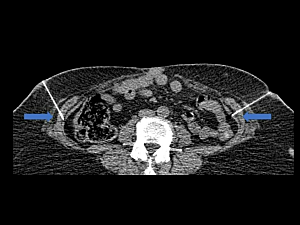For some patients, surgery to cut and release the abdominal wall muscles may be necessary to fully repair complex ventral hernias. But select patients may benefit from a technique that employs injections of botulinum toxin A (Botox) to relax the abdominal muscles before surgery, enabling the surgeon to repair these large hernias less invasively.
Eric G. Sheu, MD, PhD, section chief of Bariatric and Foregut Surgery and a member of the Complex Hernia Center at Brigham and Women’s Hospital, has performed several of these procedures. They have allowed complex hernia repairs to be performed via a minimally invasive, robotic approach and have been well-tolerated by patients.
“There’s been a movement in hernia repair to really close the muscle tears completely, which we know provides the best outcomes for patients,” Dr. Sheu says. “By giving Botox injections before surgery to relax the lateral abdominal wall muscles, we’re able to create the laxity that allows us to restore a patient’s abdominal wall anatomy and core function.”
A New Option for Repairing Mid-sized Hernias
For smaller ventral hernia repairs, the muscles can usually be brought together with no additional procedures. For very large repairs, meanwhile, more complex surgery to release the muscles may still be needed.
“The Botox technique seems to work best when you’re in that middle zone, where the muscles are a bit too contracted laterally to come together, but where a more invasive procedure may not be needed,” Dr. Sheu says. “For medium-sized hernias, particularly in patients who have had a recurrence, this can be a very good option.”
This approach is still relatively uncommon, but several studies have found that Botox injections result in changes to the abdominal wall that make hernia repair surgery less complicated and more effective.
“As far as recovery from this procedure goes, it still may be more difficult than what you would have for a simple hernia, but not having to do the surgical release certainly makes it easier for patients,” Dr. Sheu says. “These procedures can often be done on an outpatient basis or require only a one-night hospital stay, compared with these more complex surgeries that usually require at least a couple of nights in the hospital.”
A Partnership Between Surgery and Radiology
This procedure requires a partnership between surgery and radiology. It includes imaging to determine which patients are most likely to benefit from the procedure as well as the involvement of an interventional radiologist who performs the Botox injections under the guidance of either ultrasound or CT.
Patients receive the injections two or more weeks before surgery to allow their muscles to relax fully. They receive a total of six injections, three on each side of the abdomen.
Daniel I. Glazer, MD, medical director of CT and director of Cross-Sectional Interventional Radiology at the Brigham, collaborates with Dr. Sheu on these procedures to ensure optimal placement of the Botox injections.
“As interventional radiologists, we’re well-positioned to do this type of procedure. We understand the anatomy and have the ability to accurately place the needles where they need to go,” Dr. Glazer says. “This collaboration allows us to work on a fairly innovative technique and help patients avoid more complex, invasive surgeries. It’s better for the patients both in terms of having a successful procedure and reducing morbidity.”
Innovative Care for Patients With Complex Hernias
This procedure is just one of the many novel approaches being offered to patients through the Brigham’s Comprehensive Hernia Center. The center includes board-certified general and gastrointestinal surgeons who have expertise in diagnosing and treating all types of hernias, including those that are very large, very complex, or recurrent. Experts in the center are skilled in the full range of hernia surgeries, including open, minimally invasive, and robotic surgical techniques.
The team also includes board-certified plastic and reconstructive surgeons who excel in complex abdominal wall reconstruction when direct closure is impossible and experts in wound healing who can help optimize cosmetic outcomes.
In addition to performing hernia repair surgeries, the center helps patients address any factors that could prevent a successful surgery and recovery. These include guidance in smoking cessation, a diabetes management program, and help with weight loss to reduce the chances of developing another hernia.
“We created this center to ensure that patients get all the medical and surgical care needed to have the best outcomes for their hernia repair,” Dr. Sheu says.
